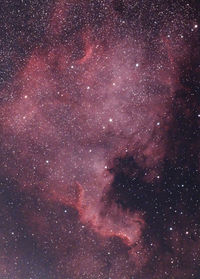North America Nebula
 From Conservapedia
From Conservapedia | North America Nebula | |
|---|---|

| |
| Observational Data | |
| Designation | NGC 7000 Cadwell 20 |
| Right ascension | 20h 58m 48s[1] |
| Declination | +44° 20′[1] |
| Constellation | Cygnus |
| Type of object | Emission nebula |
| Dimensions | 120' x 100'[2] |
| Magnitude | Apparent Mag: +4.5-12[2] |
| Astrometry | |
| Distance from Earth | 1,600 ly[1] |
The North America nebula (NGC 7000, Cadwell 20) is an emission nebula in the constellation of Cygnus, the swan.[3] The nebula's name derives from its resemblance to the North American continent. John Herschel discovered the nebula, cataloguing it as h 2096 and as GC 4621 in the General Catalogue, at some point before 1833.[1] It may have been observed earlier by his father, William Herschel, as he recorded a large faint nebula in the same region. It was first photographed by Max Wolf on December 12, 1890. The nebula can be observed using binoculars to be around 3 degrees east of the bright star Deneb (Alpha Cygni).[2] It can be seen with the naked-eye but a small amount of light pollution renders the nebula invisible.
Properties and Structure[edit]
Located 1,600 light years away, the nebula is around 50-56 light years across.[1][3] The brightness of the nebula varies drastically across the nebula, with the brightest regions having an apparent magnitude of +4.5 while the dimmest areas have an apparent magnitude of +12.[2] The nebula overall however is generally very faint and has a low surface brightness. The brightest areas of the nebula that resembles Central America and Mexico is composed dust, hot gas and stars, a region known as the Cygnus Wall.
The nebula is likely associated with three nearby open star clusters. NGC 6989, discovered by William Herschel in 1790, is located in the North-West region of the nebula.[1] Near NGC 6989 is NGC 6996, discovered by John Herschel in 1833. NGC 6997, discovered by William Herschel in 1786, is situated on the western side of the nebula.
In infrared images of the nebula taken by the Spitzer Space Telescope, over 2,000 stars have been detected within the nebula.[4] These stars are not visible in normal images because of the dust in the nebula. A large group of stars are thought to be affecting the nebula but it is unknown as to where they are located.
References[edit]
- ↑ 1.0 1.1 1.2 1.3 1.4 1.5 NGC 7000 from messier.seds.org
- ↑ 2.0 2.1 2.2 2.3 NGC 7000 - The North American Nebula from freestarcharts.com
- ↑ 3.0 3.1 The North America Nebula from apod.nasa.gov
- ↑ New View of Family Life in the North American Nebula from nasa.ogv
| ||||||||||||||||||||
Categories: [Astronomy] [Nebulae]
↧ Download as ZWI file | Last modified: 02/18/2023 07:27:40 | 200 views
☰ Source: https://www.conservapedia.com/North_America_Nebula | License: CC BY-SA 3.0
 ZWI signed:
ZWI signed: KSF
KSF